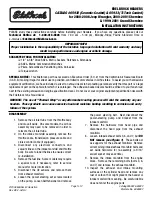
ing effect can be increased by applying
more pressure to the brake pedal.
·
You must drive particularly carefully
when driving with new brake pads in or-
der to reduce the risk of accidents, seri-
ous injuries and loss of control of the ve-
hicle.
·
Never drive too close to other vehicles
when running in new brake pads, and
never create a driving situation that will
place a heavy load on the brakes.
WARNING
Overheated brakes reduce the braking ef-
fect and considerably increase the braking
distance.
·
When driving downhill, the brakes are
placed under particular strain and be-
come hot very quickly.
·
Before driving down a long, steep gradi-
ent, reduce your speed and select
a higher recuperation level. This will
make use of the electric drive braking
effect and relieve the load on the brakes.
·
Non-standard or damaged front spoilers
could restrict the airflow to the brakes
and cause them to overheat.
WARNING
Wet brakes or brakes coated with ice or
road salt react more slowly and require lon-
ger braking distances.
·
Carefully apply the brakes to test them.
·
Always dry brakes and clean off any
coating of ice and salt with a few cau-
tious applications of the brakes when
visibility, weather, road and traffic con-
ditions permit.
Regularly perform a visual check of the
thickness of the front brake pads
through the openings in the rims or from the
underside of the vehicle. If necessary, remove
the wheels to carry out a comprehensive
check. Volkswagen recommends using
a Volkswagen dealership for this purpose.
When the front brake pads are
checked, the brake pads in the drum
brakes on the rear axle should also be
checked at the same time. This check is per-
formed though an inspection hole on the rear
of the drum. A sealing plug must be removed
for this purpose. Volkswagen recommends
using a Volkswagen dealership for this pur-
pose.
Driving a loaded vehicle
For good vehicle handling when driving a loa-
ded vehicle, please observe the following:
— Stow all items of luggage securely
— Accelerate particularly cautiously and
carefully.
— Avoid sudden braking and driving manoeu-
vres.
— Brake earlier than in normal driving.
— If applicable, observe the information con-
cerning the roof carrier → page 262,
— If applicable, observe the information
about driving with a trailer → page 264.
WARNING
Shifting loads can severely impair the vehi-
cle’s stability and driving safety, lengthen
the braking distance in the event of braking
hard, and cause accidents and serious inju-
ries.
·
Secure objects properly to prevent them
from sliding.
·
Use suitable lashing or securing straps
when securing heavy objects.
·
Securely engage the rear seat backrests.
NOTICE
Do not carry large quantities of liquid in the
vehicle interior. Leaking liquids can get into
the plug connections of the orange high-volt-
age cables. This can cause damage to the
132
Driving
















































